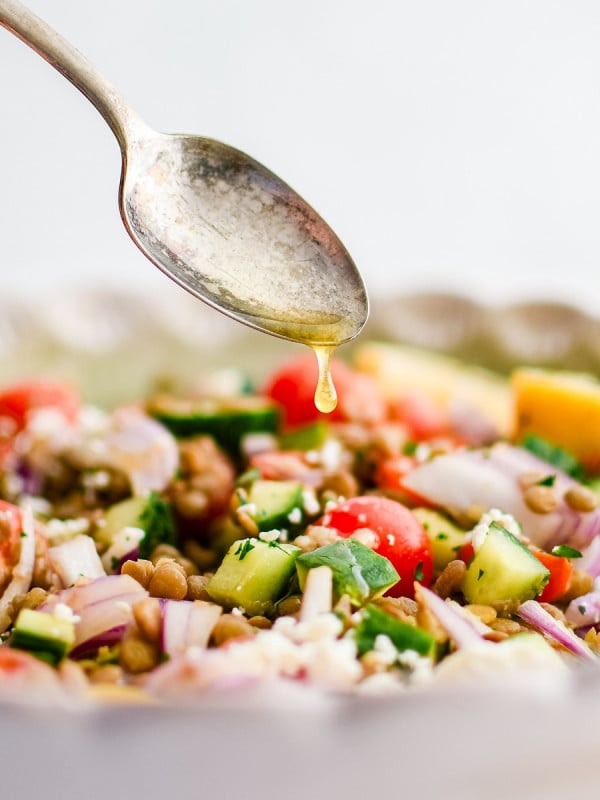This post may contain affiliate links. See my disclosure policy.
Learn How to Cook Lentils perfectly every time on the stovetop and in the Instant Pot! Full of tips and tricks, I’ll teach you how to cook tender, flavorful, and nutritious lentils perfect for salads, soups, and side dishes.
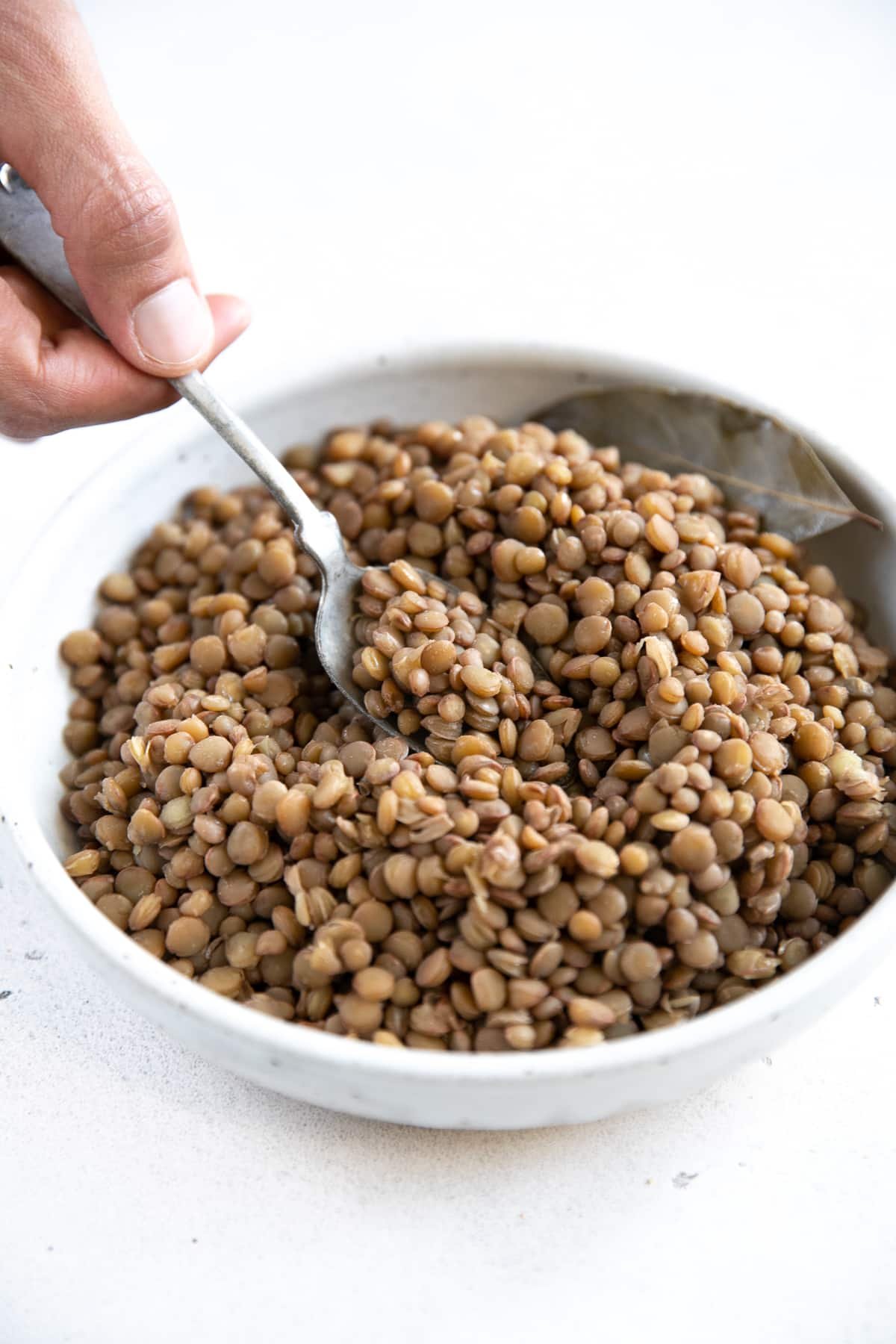
How to Cook Lentils on the Stovetop or in the Instant Pot
Lentils are a must-have ingredient for any home cook. As one of the easiest ways to incorporate plant-based meals into your weekly meal plan, they’re highly versatile, affordable, and easy to cook. Different types have different flavors, but most varieties are happy to take on the taste of whatever they’re paired with.
In this post, you’ll discover how to cook perfectly tender lentils on the stovetop and in the pressure cooker (Instant Pot). I’ll share tips and tricks for adding flavor and avoiding mushy, overcooked lentils, along with information about the different varieties and when to use them.
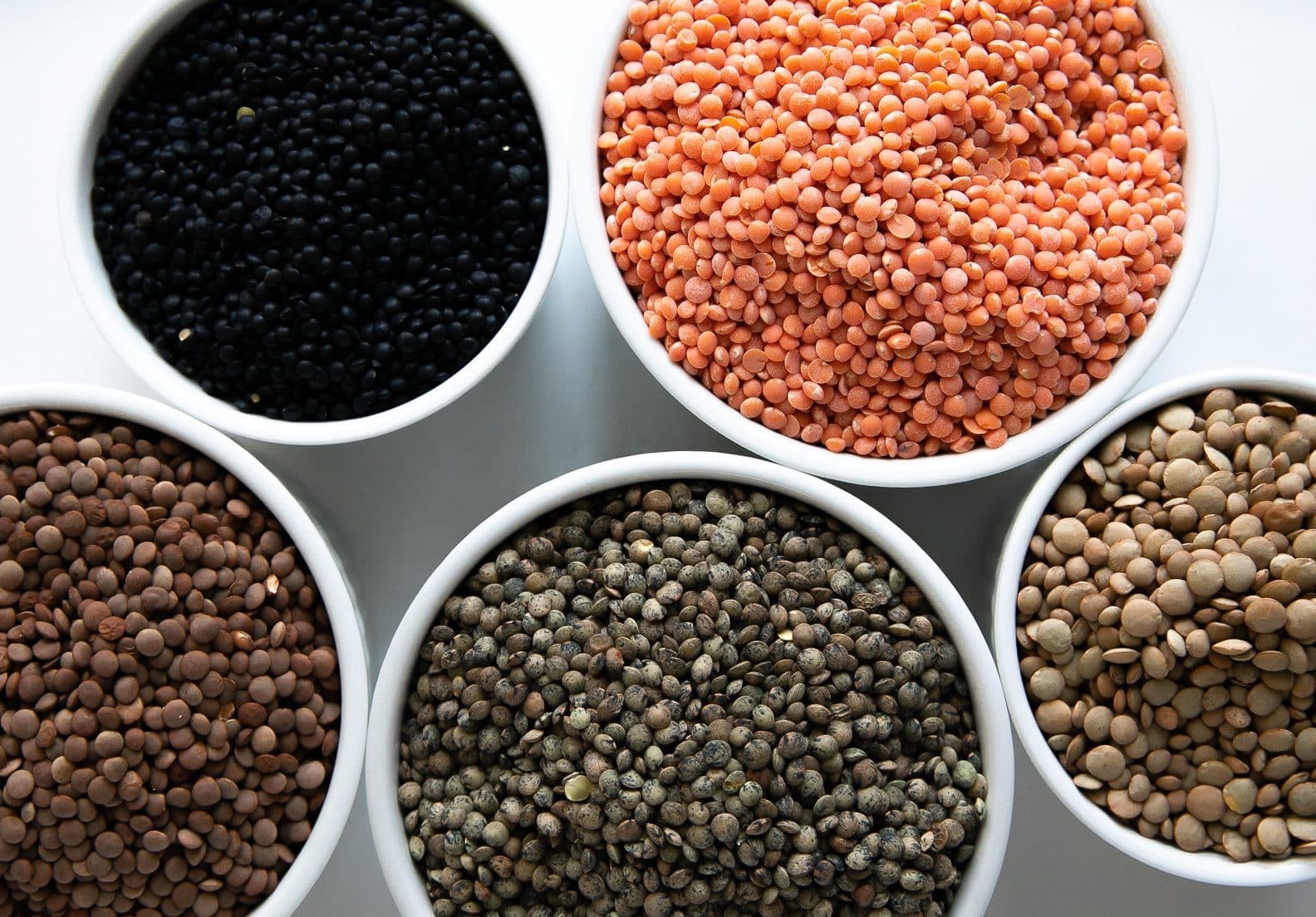
Lentils: What They Are, Popular Types, And When to Use Them
Lentils, or pulses, are one of the most ancient food crops. They are a type of legume, like chickpeas, beans, and peas, and a popular source of plant-based protein. Dried lentils comprise approximately 25% protein, making them one of the best plant-based protein sources. They’re also low in fat and a great source of vitamins and minerals, like magnesium, calcium, potassium, zinc, phosphorus, and the essential amino acid lysine, making them a nutritious addition to any meal.
Brown Lentils

Brown lentils have a mild, earthy flavor and cook in about 20-30 minutes, however, prolonged cooking and these lentils will split and fall apart, resulting in a thick, mushy consistency perfect for soup and stew like this Vegetarian Lentil Stew. Best for, salads, side dishes, veggie burgers, and stews.
Green Lentils

Green lentils are very similar to brown lentils in taste, texture, and cooking time. And just like brown lentils, they retain their shape unless overcooked. I enjoy adding green lentils to salads or dressed up with some lemon juice, salt, and pepper. They’re also great in these Lentil Sloppy Joes or this easy Lentil Soup Recipe.
Red Lentils (Masoor Dal)

Red lentils are the way to go if you’re looking to make a soup or stew. They are sold “split” into two halves, making them one of the fastest-cooking lentils available and practically disintegrate during cooking. I love using red lentils to make make this Red Lentil Recipe (Indian Masoor Dal) and Curried Coconut Lentil Soup.
French Green Lentils (Puy Lentils)

These gorgeous little guys are are chewy and somewhat peppery and hold their shape after cooking. Puy lentils (aka Lentilles du Puy) are a specific type of French green lentils. They cook in about 25-30 minutes and are a favorite in salads and side dishes where lentils are meant to stand out from other ingredients.
Black Beluga Lentils

My favorite type of lentil, these black beauties are are small, shiny, and egg-shaped with a firm texture and mild, somewhat earthy flavor. They hold their shape exceptionally well after cooking, making them a great choice for this Lentil Salad.
How to Cook Lentils (2 Ways)
After several rounds of testing, I found that the best way to cook lentils is on the stovetop (first) and in the Instant Pot (second). The methods outlined below were tested with brown and green lentils. If you’re cooking other lentil varieties, you may need to adjust their cooking times. In general, red lentils require the least time, while black beluga and French green (Puy) lentils require the most.
Do lentils need to be soaked before cooking? No. Unlike some other legumes, lentils do not need to be soaked before cooking, which saves time and preserves many of their nutrients.
Stovetop Lentils
1. Rinse: Rinse the lentils in a fine mesh strainer under cold water to remove dust and dirt. Check for discolored or broken lentils and discard them.
2. Simmer: Unlike cooking quinoa, there’s no need to measure an exact amount of water or broth when cooking lentils on the stovetop. Transfer the rinsed, drained lentils to a medium pot and fill with enough water to cover the lentils by about 1 inch. Bring to a boil, then immediately reduce the heat to low. Cover and simmer until they’re tender (not mushy), about 20-30 minutes. Check for doneness occasionally. Cooking time will vary depending on what type of lentils are being cooked.
3. Drain: Drain in a fine-mesh strainer and season with salt and pepper, if desired.
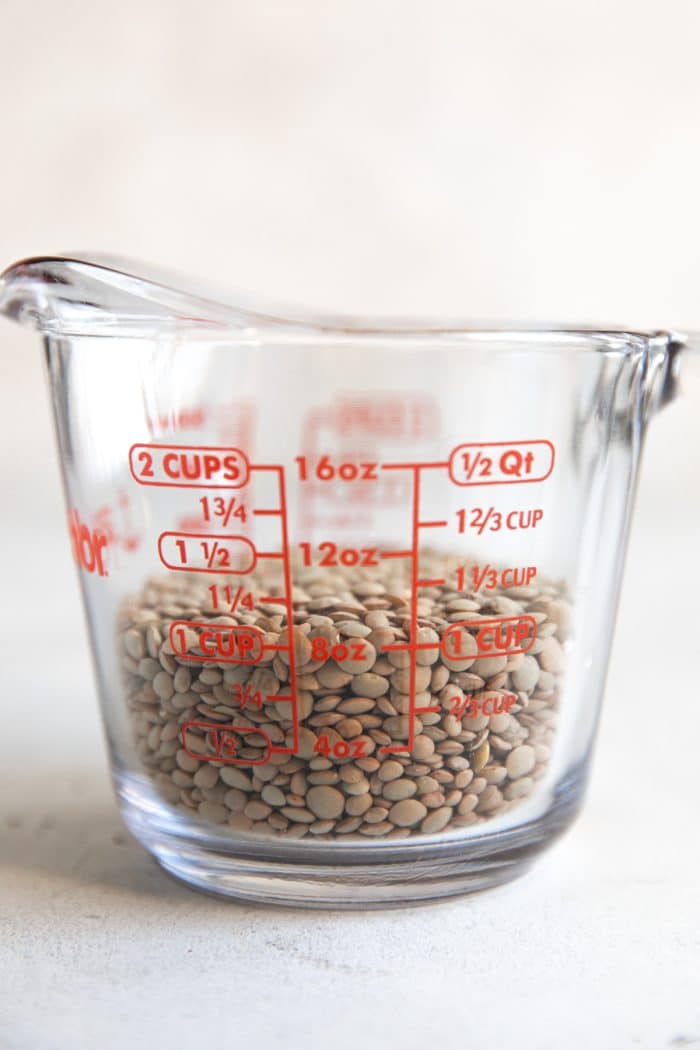
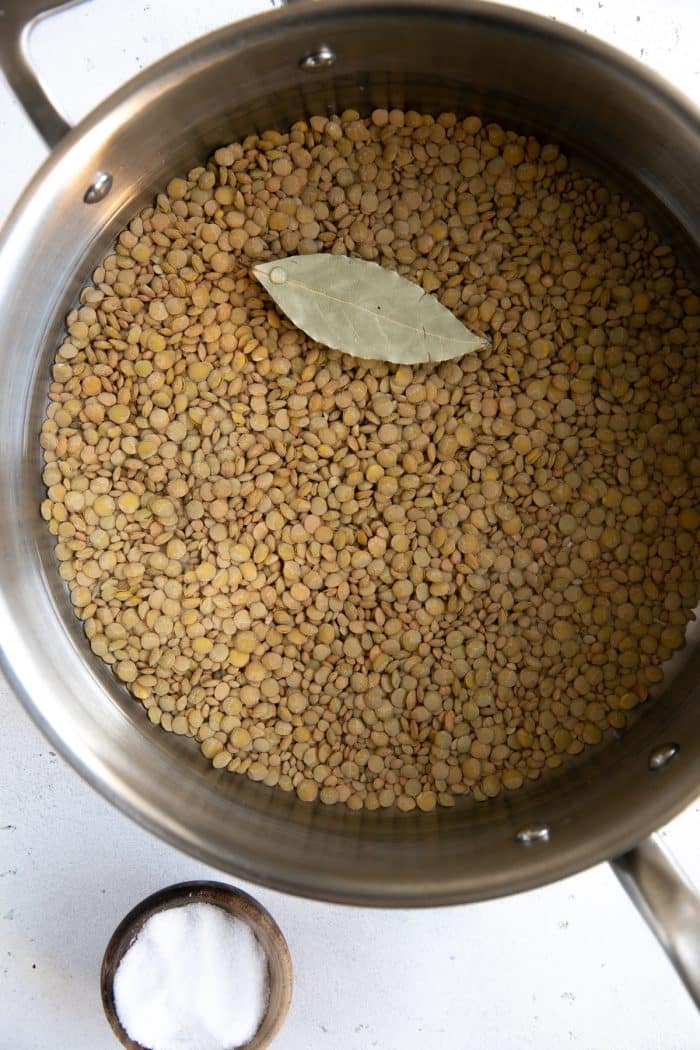

Adding Flavor to Cooked Lentils
Easy ways to add flavor include cooking the lentils in broth rather than water. Feel free to add a bay leaf, fresh rosemary or thyme, shallot, or smashed garlic cloves to infuse the simmering lentils with even more flavor. After cooking, gently toss the lentils with one or more of the following: olive oil, red wine vinegar, fresh minced parsley, lemon juice, salt, and black pepper.
Instant Pot Lentils
1. Rinse: Rinse the lentils in a fine mesh strainer under cold water to remove dust and dirt. Check for discolored or broken lentils and discard them.
2. Pressure cook the lentils: Place one cup of lentils and two cups of water (or broth) in your Instant Pot. Close the lid and set to the “sealing” position. Cook on manual, high pressure for 5 minutes, followed by a natural release of 5 minutes. Then carefully release any remaining pressure by manually moving the pressure release knob to the “venting” position. Once all of the pressure is released, remove the lid.
3. Strain: Check the lentils for doneness, then immediately drain them in a fine-mesh strainer and season as desired. Tip: If the lentils need more cooking time, cover the pot and allow them to soak up some broth.
Jessica’s Cooking Tip: I do not recommend cooking split lentils (i.e., red and yellow) in the Instant Pot unless you’re making soup. Even a considerably shorter cooking time will result in mushy lentils.

Tips for the Best Lentils
- Choose the right type: Different types of lentils are best for different dishes. Red lentils break down quickly, making them the best choice for soups and stews. Green and brown lentils hold their shape and texture when cooked properly, making them great for side dishes and salads, but cooked long enough, they, too, will break down. French green (Puy) and black Beluga lentils are ideal when firm and intact lentils are desired.
- Cook gently: After the lentils reach a boil, reduce the heat to a gentle simmer. Rapid boiling can cause the lentils to split and become mushy.
- Simmer with aromatics, but season at the end: Simmer your lentils with aromatics such as garlic, onion, and fresh herbs, but wait until the end to season with salt or acidic ingredients such as vinegar, lemon juice, or tomatoes, as these things can toughen lentils and increase the cooking time.
- Avoid overcooking: Check the progress of your lentils regularly.
How to Store Lentils
Dry and uncooked, your lentils can stay fresh for up to one year in a cool, dry, dark place. That’s not to say that beyond one year they’ve turned “bad”. Rather, after one year, it is likely that your lentils have started to lose some flavor.
Once cooked, plain lentils can last up to a week in the refrigerator if they’re sealed and stored in an airtight container. Alternatively, you may also freeze your cooked lentils for up to six months. Be careful when reheating frozen lentils as they are especially sensitive to splitting.
You may also enjoy these other helpful cooking posts:
- 15 Types of Beans – And How to Use Them
- Popular Types of Lentils
- Couscous: What Is It, Recipes, and How to Cook Couscous
- Different Types of Rice: Varieties and What to Do With Them
- Potato Types: A Guide to Popular Types of Potatoes
- Types of Oats
- What Are Groats?
- Barley: What Is It And Is It Good For You?

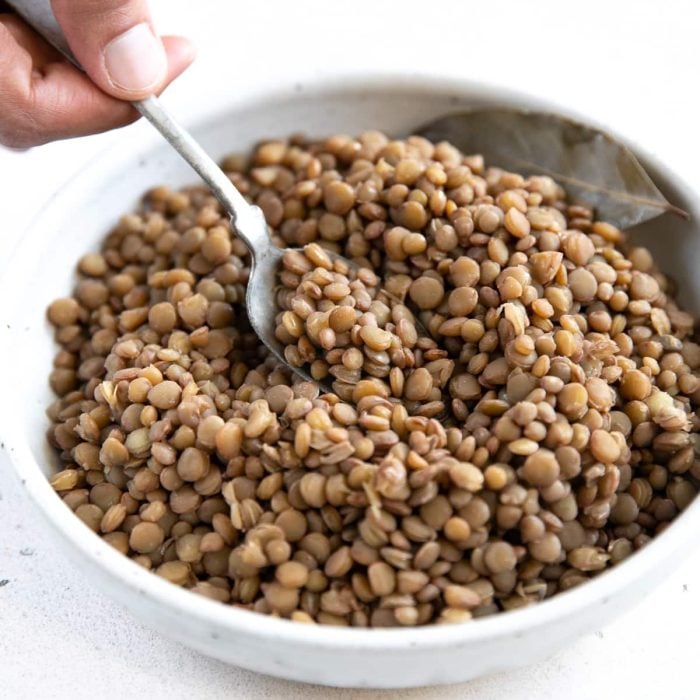
How to Cook Lentils (Stovetop and Instant Pot)
Ingredients
- 1 cup brown, or green lentils
- water, or vegetable broth, see notes
- 1 bay leaf, optional
Instructions
Stovetop Lentils
- Rinse the lentils in a fine mesh strainer under cold water to remove dust and dirt. Check for discolored or broken lentils and discard them.
- There’s no need to measure an exact amount of water or broth when cooking lentils on the stovetop. Transfer the rinsed, drained lentils to a medium pot and fill with enough water to cover the lentils by about 1 inch. Bring to a boil, then immediately reduce the heat to low. Cover and simmer until they’re tender (not mushy), about 20-30 minutes. Check for doneness occasionally.
- Drain in a fine-mesh strainer and season with salt and pepper, if desired.
Instant Pot (Pressure Cooker) Lentils
- Rinse the lentils in a fine mesh strainer under cold water to remove dust and dirt. Check for discolored or broken lentils and discard them.
- Place one cup of lentils and three cups of water (or broth) in your Instant Pot. Close the lid and set to the “sealing” position. Cook on manual, high pressure for 5 minutes, followed by a natural release of 5 minutes. Then carefully release any remaining pressure by manually moving the pressure release knob to the “venting” position. Once all of the pressure is released, remove the lid.
- Check the lentils for doneness, then immediately drain them in a fine-mesh strainer and season as desired. Tip: If the lentils need more cooking time, cover the pot and allow them to soak up some broth.
Notes
- There is no need to soak lentils before cooking.
- This recipe is: gluten-free, vegetarian, vegan, dairy-free.
- Adding flavor: The easiest way is to cook the lentils in broth rather than water. Feel free to add a bay leaf, fresh rosemary or thyme, shallot, or smashed garlic cloves to infuse the simmering lentils with even more flavor. After cooking, gently toss the lentils with one or more of the following: olive oil, red wine vinegar, fresh minced parsley, lemon juice, salt, and black pepper.
- Storage: Cooked lentils will last for one week in the refrigerator or frozen for up to 6 months.
- Cooking lentils is like cooking pasta, rather than cooking them until all the liquid is absorbed check for doneness starting approximately halfway through cooking. Cook until al dente or tender with a slight bite to the middle.
- After the lentils reach a boil, reduce the heat to a gentle simmer. Rapid boiling can cause the lentils to split and become mushy.
Nutrition
Nutrition information is automatically calculated, so should only be used as an approximation.






